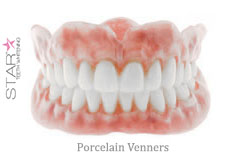Have you ever been dissatisfied with your smile? Whether from a gap, chipped tooth, or misshapen teeth, veneers may be the solution you’re looking for.
Veneers are thin covers that get placed over the teeth. They adhere to your teeth and provide a classic and aesthetically pleasing tooth look.
Veneers can be made of porcelain or composite resin material. Your dentist will help you pick the best material for you, but let’s go over the differences between the two types.
Porcelain Veneers

Porcelain veneers are custom-made for the tooth, so they always have a perfect fit.
The benefits of porcelain veneers include:
- A natural-looking surface
- strong and long-lasting
- don’t stain easily
- requires less tooth enamel to be removed than with a crown or cap
The procedure to place a porcelain veneer begins by removing a small amount of enamel from the front and sides of the teeth. This is done to make room for the veneers. The dentist will then take a mold of the teeth getting the veneers and choose the veneer shade.
This mold is sent to a dental lab that will make the porcelain veneers according to the mold, which may take several days. Once the veneers are made, the dentist will place them on your teeth, checking their fit and shape. They will make adjustments as needed, and once everything looks good, they will bond the veneers to the tooth.
Some downsides of this type of veneer are that they are more expensive and require more office visits to put into place.
Composite Resin Veneers
This type of veneer is made from a tooth-colored filling material that is bonded to the tooth.
The benefits of composite resin veneers include:
- cost less than porcelain veneers
- requires less tooth enamel to be removed than for crowns or porcelain veneers
- easily fixed if damaged
- may take only one visit to put on
The procedure to place composite resin begins in the same way as porcelain veneers, by removing a small amount of the enamel to prepare the teeth. Once the teeth are ready, the dentist will carefully sculpt and bond the composite material. Once the material is in place, they use a special light to harden the composite to the teeth. The dentist then smooths and polishes the veneers so that they look like natural teeth.
One con for this type of veneer is that they do not last as long as porcelain veneers. However, if damaged, they are easily fixed.
Are You a Candidate for Veneers?
Before getting veneers, it is imperative that the gums are healthy. If you want veneers, but your gums are not healthy, a dentist can treat any disease or decay. However, it needs to be treated before the veneers are placed.
Veneers are also not a great choice for those who clench or grind their teeth. The veneers are thin, and these actions can chip or break them.
The Cost of Veneers
The Consumer Guide to Dentistry averages the cost of traditional porcelain veneers to be between $925 and $2,500 per tooth. This cost depends on the type of veneer chosen, brand name, area’s cost of living, and the dentist’s expertise. These veneers also last on average 10 to 15 years. On the other hand, composite resin veneers last only 5 to 7 years, and they cost between $250 to $1,500 per tooth, with the same factors affecting the price.
